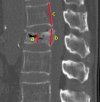Correlation analysis of the vertebral compression degree and CT HU value in elderly patients with osteoporotic thoracolumbar fractures
- PMID: 37365576
- PMCID: PMC10294538
- DOI: 10.1186/s13018-023-03941-z
Correlation analysis of the vertebral compression degree and CT HU value in elderly patients with osteoporotic thoracolumbar fractures
Abstract
Background: To explore the correlation of the vertebral compression degree and cancellous bone CT HU in elderly patients with osteoporotic thoracolumbar fractures.
Methods: Elderly patients with single-segment vertebral fragility fractures were retrospectively reviewed. All patients experienced a low-energy trauma and underwent thoracolumbar MRI. The consistency of measurement between two spine surgeons was evaluated. The average CT HU value of the adjacent vertebral body was used instead.
Results: A total of 54 patients were included in the final analysis. The patients' average age was 70.39 ± 8.53 years, and the average CT HU value was 72.78 ± 29.75 HU. The average vertebral compression ratio was 0.57 ± 0.16. Measurements showed both good intrarater repeatability and good interrater reproducibility of the vertebral compression ratio (ICC = 0.978). The degree of vertebral compression in thoracolumbar osteoporotic fractures was strongly positively correlated with the cancellous bone CT HU value (P < 0.01).
Conclusions: The local bone quality as evaluated by the CT HU value is an important factor affecting the degree of compression in osteoporotic vertebral fractures. This study provides quantitative evidence that a greater compression ratio with thoracolumbar osteoporotic fractures was associated with lower bone density in elderly patients. Further longitudinal studies with larger cohorts are needed to verify this relationship.
Keywords: BMD; CT hounsfield unit; Cancellous bone; Osteoporotic thoracolumbar fractures.
© 2023. The Author(s).
Conflict of interest statement
Cheng Li, Xing-ming Lai, Nian Liu, Yang Lin, Wei Hu declare that they have no conflict of interest.
Figures



Similar articles
-
Vertebral CT Hounsfield units in postmenopausal women with osteoporotic vertebral compression fracture: identification and validation of reference intervals.Eur Spine J. 2025 May;34(5):1663-1672. doi: 10.1007/s00586-025-08828-7. Epub 2025 Apr 3. Eur Spine J. 2025. PMID: 40175644
-
CT measurement and analysis of the target vertebral body in elderly patients with uncompressed osteoporotic thoracolumbar fractures.Eur Rev Med Pharmacol Sci. 2018 Jul;22(1 Suppl):36-44. doi: 10.26355/eurrev_201807_15357. Eur Rev Med Pharmacol Sci. 2018. PMID: 30004568
-
[Effectiveness of long segment fixation combined with vertebroplasty for severe osteoporotic thoracolumbar compressive fractures].Zhongguo Xiu Fu Chong Jian Wai Ke Za Zhi. 2013 Nov;27(11):1331-7. Zhongguo Xiu Fu Chong Jian Wai Ke Za Zhi. 2013. PMID: 24501892 Chinese.
-
Using advanced imaging to measure bone density, compression fracture risk, and risk for construct failure after spine surgery.Spine J. 2024 Jul;24(7):1135-1152. doi: 10.1016/j.spinee.2024.02.018. Epub 2024 Mar 2. Spine J. 2024. PMID: 38437918 Review.
-
New Osteoporotic/Vertebral Compression Fractures.2022 Mar 9. In: Feingold KR, Ahmed SF, Anawalt B, Blackman MR, Boyce A, Chrousos G, Corpas E, de Herder WW, Dhatariya K, Dungan K, Hofland J, Kalra S, Kaltsas G, Kapoor N, Koch C, Kopp P, Korbonits M, Kovacs CS, Kuohung W, Laferrère B, Levy M, McGee EA, McLachlan R, Muzumdar R, Purnell J, Rey R, Sahay R, Shah AS, Singer F, Sperling MA, Stratakis CA, Trence DL, Wilson DP, editors. Endotext [Internet]. South Dartmouth (MA): MDText.com, Inc.; 2000–. 2022 Mar 9. In: Feingold KR, Ahmed SF, Anawalt B, Blackman MR, Boyce A, Chrousos G, Corpas E, de Herder WW, Dhatariya K, Dungan K, Hofland J, Kalra S, Kaltsas G, Kapoor N, Koch C, Kopp P, Korbonits M, Kovacs CS, Kuohung W, Laferrère B, Levy M, McGee EA, McLachlan R, Muzumdar R, Purnell J, Rey R, Sahay R, Shah AS, Singer F, Sperling MA, Stratakis CA, Trence DL, Wilson DP, editors. Endotext [Internet]. South Dartmouth (MA): MDText.com, Inc.; 2000–. PMID: 25905264 Free Books & Documents. Review. No abstract available.
Cited by
-
Feasibility study in quantitative identification of fresh and old osteoporotic vertebral compression fracture by vertebral CT value and CT value difference.BMC Musculoskelet Disord. 2024 Oct 19;25(1):821. doi: 10.1186/s12891-024-07936-7. BMC Musculoskelet Disord. 2024. PMID: 39427115 Free PMC article.
-
Quantitative lung CT indicators have good predictive ability for hypoxemia during one-lung ventilation in radical resection for lung cancer.J Anesth. 2025 Jun;39(3):416-425. doi: 10.1007/s00540-025-03483-0. Epub 2025 Mar 22. J Anesth. 2025. PMID: 40119942
-
Hounsfield unit for assessing bone mineral density distribution within lumbar vertebrae and its clinical values.Front Endocrinol (Lausanne). 2024 Jun 13;15:1398367. doi: 10.3389/fendo.2024.1398367. eCollection 2024. Front Endocrinol (Lausanne). 2024. PMID: 38938515 Free PMC article.
-
Evaluating bone mineral density in osteoporotic vertebral compression fractures: the clinical utility of anterior column Hounsfield units.Front Endocrinol (Lausanne). 2025 Mar 20;16:1552780. doi: 10.3389/fendo.2025.1552780. eCollection 2025. Front Endocrinol (Lausanne). 2025. PMID: 40182640 Free PMC article.
-
Study on the consistency between CT hounsfield units and MRI evaluation of preoperative cervical paraspinal muscular fat infiltration in patients undergoing ACDF.J Orthop Surg Res. 2024 Jul 26;19(1):435. doi: 10.1186/s13018-024-04935-1. J Orthop Surg Res. 2024. PMID: 39061068 Free PMC article.
References
Publication types
MeSH terms
LinkOut - more resources
Full Text Sources
Medical

